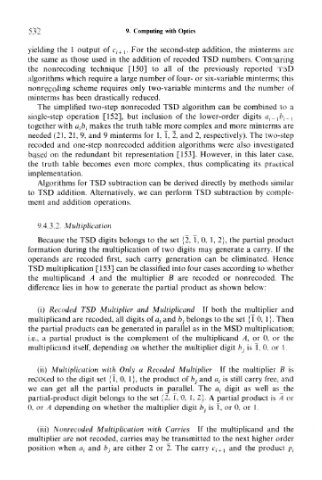Page 547 - Introduction to Information Optics
P. 547
532 9. Computing with Optics
yielding the 1 output of c i+1. For the second-step addition, the minterms are
the same as those used in the addition of receded TSD numbers. Comparing
the nonrecoding technique [150] to all of the previously reported TSD
algorithms which require a large number of four- or six-variable minterms; this
nonrecoding scheme requires only two-variable minterms and the number of
minterms has been drastically reduced.
The simplified two-step nonrecoded TSD algorithm can be combined to a
single-step operation [152], but inclusion of the lower-order digits a i_ lb i, l
together with a ib i makes the truth table more complex and more minterms are
needed (21, 21, 9, and 9 minterms for 1,1, 2, and 2, respectively). The two-step
recoded and one-step nonrecoded addition algorithms were also investigated
based on the redundant bit representation [153]. However, in this later case,
the truth table becomes even more complex, thus complicating its practical
implementation.
Algorithms for TSD subtraction can be derived directly by methods similar
to TSD addition. Alternatively, we can perform TSD subtraction by comple-
ment and addition operations.
9.4.3.2. Multiplication
Because the TSD digits belongs to the set (2, T, 0, 1, 2), the partial product
formation during the multiplication of two digits may generate a carry. If the
operands are recoded first, such carry generation can be eliminated. Hence
TSD multiplication [153] can be classified into four cases according to whether
the multiplicand A and the multiplier B are recoded or nonrecoded. The
difference lies in how to generate the partial product as shown below;
(i) Recoded TSD Multiplier and Multiplicand If both the multiplier and
multiplicand are recoded, all digits of a,- and bj belongs to the set (T 0, 1}. Then
the partial products can be generated in parallel as in the MSD multiplication;
i.e., a partial product is the complement of the multiplicand A, or 0. or the
multiplicand itself, depending on whether the multiplier digit b f is T, 0, or 1.
(ii) Multiplication with Only a Recoded Multiplier If the multiplier B is
recoded to the digit set (I, 0, 1}, the product of bj and a t is still carry free, and
we can get all the partial products in parallel. The a t digit as well as the
partial-product digit belongs to the set (2, T, 0, 1, 2}. A partial product is A or
0, or A. depending on whether the multiplier digit bj is T, or 0, or 1.
(iii) Nonrecoded Multiplication with Carries If the multiplicand and the
multiplier are not recoded, carries may be transmitted to the next higher order
position when a t and b f are either 2 or 2. The carry c i+l and the product PJ

